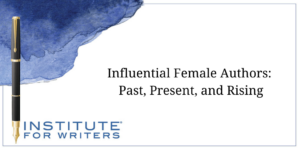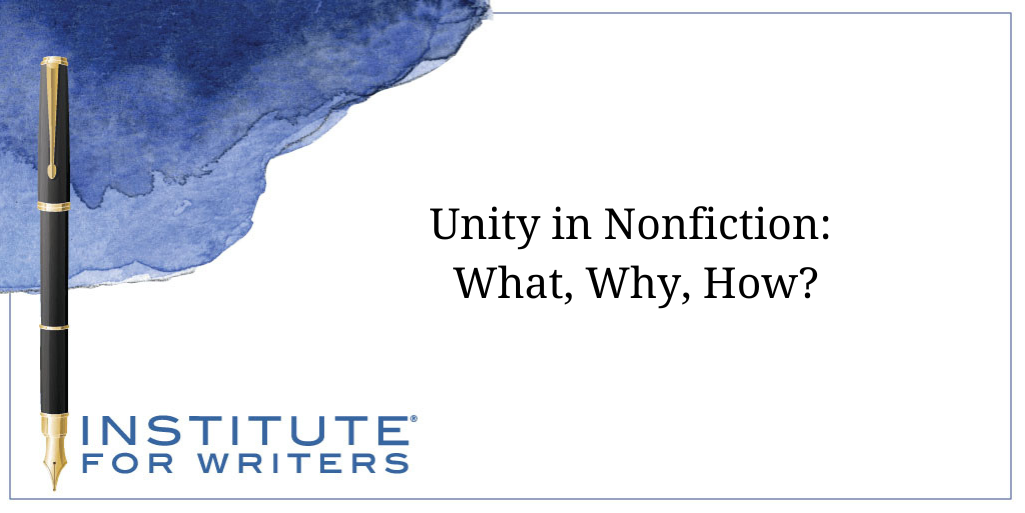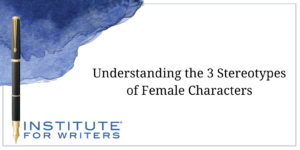
Influential Female Authors: Past, Present, and Rising
We’re going to look at influential female authors of the past, those impacting the present, and whom the industry expects to make a big splash.

Open a book about the craft of nonfiction and you’ll likely find advice on creating unity in your writing. In his classic On Writing Well, William Zinsser called unity “the anchor of good writing.” Unity in nonfiction means the writing is cohesive and coherent, and the parts create a meaningful whole. We look for unity in art, music, décor, and fashion, too. Imagine seeing a lime-green molded plastic chair in a room full of early American furnishings. And what if Audrey Hepburn had worn metallic platform sandals instead of simple black pumps with her “little black dress” in the film Breakfast at Tiffany’s?
 While reading nonfiction, we expect the author to present things in an organized, purposeful way that helps us make sense of the topic. Without unity, it’s difficult to understand what the author intended to say, or how bits of information fit together. As Zinsser writes, unity “keeps the reader from straggling off in all directions” and reassures them “that all is well at the helm.” Readers experience a sense of harmony when the writing has unity in content, style, and tone.
While reading nonfiction, we expect the author to present things in an organized, purposeful way that helps us make sense of the topic. Without unity, it’s difficult to understand what the author intended to say, or how bits of information fit together. As Zinsser writes, unity “keeps the reader from straggling off in all directions” and reassures them “that all is well at the helm.” Readers experience a sense of harmony when the writing has unity in content, style, and tone.
This process starts with choosing a topic and focusing on a manageable, meaningful aspect of that topic. A clear focus can help with the research and planning. Then we must decide what material to include and what to leave out.
Suppose you want to convince readers that organic produce is healthier to eat than conventionally grown foods? This is your thesis, or slant. Which of these subtopics doesn’t belong? (1) types of pesticides used in growing produce (2) residues of pesticides and fungicides found on conventionally grown produce (3) effects of pesticides in the body (4) how pesticides affect waterways (5) research comparing nutrient content in organic vs. conventionally grown produce.
Although #4 is important, it does not support your main point. Readers would feel a sense of disunity when they encountered such a shift and would likely wonder “Why did the author include this?” Similar issues can occur within paragraphs. For instance, if you were discussing the nutrient content in produce, a sentence about the man who first isolated Vitamin C in a lab creates disunity.
So, when it comes to content, author Gary Provost advises, “To achieve unity in your writing you must leave out anything that doesn’t belong there, no matter how witty, poetic, or profound it is.”
 As you present your chosen material, don’t forget transitions. They help to unify material by providing “bridges” and connections. Effective transitions help writing flow well from one idea, paragraph, and chapter to the next. We can use them to ease changes in subtopic, time, and place, and when making contrasts and comparisons, giving examples, and showing consequences. Example: If your previous paragraph discussed the dangers of exploring a cave, your next paragraph, on safety measures, might begin this way:
As you present your chosen material, don’t forget transitions. They help to unify material by providing “bridges” and connections. Effective transitions help writing flow well from one idea, paragraph, and chapter to the next. We can use them to ease changes in subtopic, time, and place, and when making contrasts and comparisons, giving examples, and showing consequences. Example: If your previous paragraph discussed the dangers of exploring a cave, your next paragraph, on safety measures, might begin this way:
Considering these dangers, how can you prepare and take precautions to stay safe while you’re exploring?
Transitions can also help readers make a shift in mood. For instance, if your previous paragraphs described a tragic disaster, your next paragraph might start this way:
Even amidst loss and destruction, people find signs of hope, sometimes through the kindness of strangers.
Along with unity in what you write, aim for unity in how you write it—your style. Perhaps all of your nonfiction writing displays a similar style, or maybe you change your style, depending on your topic. Either approach is fine; just stick with one per project. Your writing might be casual and conversational, with short sentences, contractions, and everyday language, or more formal, with longer sentences, no fragments or contractions, and complex words. Your use of punctuation also contributes to style.
Shifts in style can sound as if another author jumped in to write part of your article or book. Suppose you started with an amusing first-person anecdote using casual language and short, breezy sentences to describe your first job working in a hospital. Readers would feel a jolt if you went on to write this:
 Every year, hospital emergency rooms in the United States confront an increasing number of drug overdose cases, and the number of deaths from such cases exceeded 100,000 in 2021. Opioids, primarily fentanyl, were responsible for approximately 75 percent of these deaths.
Every year, hospital emergency rooms in the United States confront an increasing number of drug overdose cases, and the number of deaths from such cases exceeded 100,000 in 2021. Opioids, primarily fentanyl, were responsible for approximately 75 percent of these deaths.
This sober, more formal paragraph injects disunity in both style and tone.
Once you know what you will say and the effect you want to create, choose a suitable tone. Will it be serious, light-hearted, or in between? Knowing how you feel about your subject matter can help you maintain unity of tone. Will your attitude be objective, personally involved, amused, concerned, critical, admiring, skeptical, conspiratorial, or amazed, for example?
How will you address your reader—more like a participant or an observer? Perhaps you will talk to them directly, using second-person, as I’ve done in this blog. Or you might use a more impersonal, observational, academic tone.
As William Zinsser noted, the author is “at the helm,” responsible for keeping things on course. Think about unity in nonfiction as you write and revise:
Gary Provost sums it up this way: “Everything you write should look as if it was written at one time, by one person, with one purpose, using one language.”
Victoria Sherrow has published short stories, articles, poetry, and books for diverse age groups. Her books have received starred reviews and been honored by the American Library Association, National Association for the Advancement of Science, and NYPL Best Books for the Teenage, among others. Victoria’s most recent nonfiction book for adults is Encyclopedia of Hair: A Cultural History (ABC-CLIO, 2023). She loves helping her students tap into their experiences, interests, and imaginations to create their own stories and books.

We’re going to look at influential female authors of the past, those impacting the present, and whom the industry expects to make a big splash.

This week, we’re focusing on how we as writers can create strong female characters that others will look up to, instead of harmful stereotypes.

Is your writing routine reaching its potential? Maybe it’s time to take another look so you can see what’s possible for your writing.
1000 N. West Street #1200, Wilmington, DE 19801
© 2024 Direct Learning Systems, Inc. All rights reserved.

1000 N. West Street #1200, Wilmington, DE 19801
© 2025 Direct Learning Systems, Inc. All rights reserved.

1000 N. West Street #1200, Wilmington, DE 19801
©2025 Direct Learning Systems, Inc. All rights reserved. Privacy Policy.
2 Comments